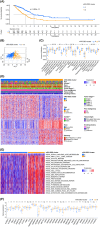Development of m6A/m5C/m1A regulated lncRNA signature for prognostic prediction, personalized immune intervention and drug selection in LUAD
- PMID: 38647237
- PMCID: PMC11034373
- DOI: 10.1111/jcmm.18282
Development of m6A/m5C/m1A regulated lncRNA signature for prognostic prediction, personalized immune intervention and drug selection in LUAD
Abstract
Research indicates that there are links between m6A, m5C and m1A modifications and the development of different types of tumours. However, it is not yet clear if these modifications are involved in the prognosis of LUAD. The TCGA-LUAD dataset was used as for signature training, while the validation cohort was created by amalgamating publicly accessible GEO datasets including GSE29013, GSE30219, GSE31210, GSE37745 and GSE50081. The study focused on 33 genes that are regulated by m6A, m5C or m1A (mRG), which were used to form mRGs clusters and clusters of mRG differentially expressed genes clusters (mRG-DEG clusters). Our subsequent LASSO regression analysis trained the signature of m6A/m5C/m1A-related lncRNA (mRLncSig) using lncRNAs that exhibited differential expression among mRG-DEG clusters and had prognostic value. The model's accuracy underwent validation via Kaplan-Meier analysis, Cox regression, ROC analysis, tAUC evaluation, PCA examination and nomogram predictor validation. In evaluating the immunotherapeutic potential of the signature, we employed multiple bioinformatics algorithms and concepts through various analyses. These included seven newly developed immunoinformatic algorithms, as well as evaluations of TMB, TIDE and immune checkpoints. Additionally, we identified and validated promising agents that target the high-risk mRLncSig in LUAD. To validate the real-world expression pattern of mRLncSig, real-time PCR was carried out on human LUAD tissues. The signature's ability to perform in pan-cancer settings was also evaluated. The study created a 10-lncRNA signature, mRLncSig, which was validated to have prognostic power in the validation cohort. Real-time PCR was applied to verify the actual manifestation of each gene in the signature in the real world. Our immunotherapy analysis revealed an association between mRLncSig and immune status. mRLncSig was found to be closely linked to several checkpoints, such as IL10, IL2, CD40LG, SELP, BTLA and CD28, which could be appropriate immunotherapy targets for LUAD. Among the high-risk patients, our study identified 12 candidate drugs and verified gemcitabine as the most significant one that could target our signature and be effective in treating LUAD. Additionally, we discovered that some of the lncRNAs in mRLncSig could play a crucial role in certain cancer types, and thus, may require further attention in future studies. According to the findings of this study, the use of mRLncSig has the potential to aid in forecasting the prognosis of LUAD and could serve as a potential target for immunotherapy. Moreover, our signature may assist in identifying targets and therapeutic agents more effectively.
Keywords: drug prediction; immunotherapy; lncRNA signature; lung adenocarcinoma; m6A/m5C/m1A; prognosis.
© 2024 The Authors. Journal of Cellular and Molecular Medicine published by Foundation for Cellular and Molecular Medicine and John Wiley & Sons Ltd.
Conflict of interest statement
The authors declare no competing interests.
Figures










Similar articles
-
Prognosis and personalized treatment prediction in lung adenocarcinoma: An in silico and in vitro strategy adopting cuproptosis related lncRNA towards precision oncology.Front Pharmacol. 2023 Feb 15;14:1113808. doi: 10.3389/fphar.2023.1113808. eCollection 2023. Front Pharmacol. 2023. PMID: 36874011 Free PMC article.
-
Crosstalk between copper homeostasis and cuproptosis reveals a lncRNA signature to prognosis prediction, immunotherapy personalization, and agent selection for patients with lung adenocarcinoma.Aging (Albany NY). 2023 Nov 26;15(22):13504-13541. doi: 10.18632/aging.205281. Epub 2023 Nov 26. Aging (Albany NY). 2023. PMID: 38011277 Free PMC article.
-
Deciphering disulfidptosis: Uncovering a lncRNA-based signature for prognostic assessment, personalized immunotherapy, and therapeutic agent selection in lung adenocarcinoma patients.Cell Signal. 2024 May;117:111105. doi: 10.1016/j.cellsig.2024.111105. Epub 2024 Feb 16. Cell Signal. 2024. PMID: 38369264
-
The role of RNA methylation in glioma progression: mechanisms, diagnostic implications, and therapeutic value.Front Immunol. 2025 May 21;16:1583039. doi: 10.3389/fimmu.2025.1583039. eCollection 2025. Front Immunol. 2025. PMID: 40469294 Free PMC article. Review.
-
Gene Signatures and Oncology Treatment Implications.Hematol Oncol Clin North Am. 2025 Apr;39(2):295-307. doi: 10.1016/j.hoc.2024.11.003. Epub 2024 Dec 17. Hematol Oncol Clin North Am. 2025. PMID: 39694780 Review.
Cited by
-
Establishment of potential lncRNA-related hub genes involved competitive endogenous RNA in lung adenocarcinoma.BMC Cancer. 2024 Nov 9;24(1):1371. doi: 10.1186/s12885-024-13144-2. BMC Cancer. 2024. PMID: 39522011 Free PMC article.
-
G0 arrest gene patterns to predict the prognosis and drug sensitivity of patients with lung adenocarcinoma.PLoS One. 2024 Aug 19;19(8):e0309076. doi: 10.1371/journal.pone.0309076. eCollection 2024. PLoS One. 2024. PMID: 39159158 Free PMC article.
-
YTHDC1 phase separation drives the nuclear export of m6A-modified lncNONMMUT062668.2 through the transport complex SRSF3-ALYREF-XPO5 to aggravate pulmonary fibrosis.Cell Death Dis. 2025 Apr 12;16(1):279. doi: 10.1038/s41419-025-07608-x. Cell Death Dis. 2025. PMID: 40221424 Free PMC article.
References
Publication types
MeSH terms
Substances
LinkOut - more resources
Full Text Sources
Research Materials
Miscellaneous

